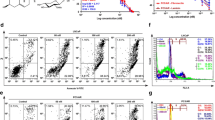Abstract
The phenylpiperazine derivative naftopidil is an α1-adrenoceptor (AR) antagonist that has been used clinically to treat benign prostatic hyperplasia. In our drug repositioning research, naftopidil shows the unique growth-inhibitory effects. Naftopidil inhibits cell cycle progression not only in cancer cells, but also in fibroblasts and vascular endothelial cells. Naftopidil-inhibited cell cycle progression is independent of α1-AR expression in cells. Therefore, the antiproliferative effects of naftopidil may be due to the off-target effects of the drug. In this study, we attempted to identify the off-target molecules of naftopidil using the magnetic nanobeads, ferrite glycidyl metharcrylate (FG) beads. Similar to naftopidil, its derivatives TG09-01 and TG09-02, which were introduced with amino groups for immobilizing to FG beads, inhibited cell growth in human HT29 colon adenocarcinoma cells. Both derivatives were associated with inhibition of cell cycle progression in HT29 cells. This observation is consistent with that seen with naftopidil. Using TG09-02-immobilized FG beads, α- and β-tubulins were identified as the specific binding proteins of naftopidil. The tubulin polymerization assay clearly indicated that naftopidil bound directly to tubulin and inhibited the polymerization of tubulin. Other phenylpiperazine derivatives, such as RS100329, BMY7378, and KN-62, also inhibited the polymerization of tubulin. These results suggest that phenylpiperazine derivatives including naftopidil may have broad spectrum of cellular cytotoxicity in various types of cells. In addition, the tubulin polymerization-inhibiting activity of phenylpiperazine derivatives may be a specific feature of the phenylpiperazine-based structure. These findings can allow us to design and synthesize new tubulin-binding drugs derived from naftopidil as a lead compound.




Similar content being viewed by others
References
Kawabe K (2006) Latest frontiers in pharmacotherapy for benign prostatic hyperplasia. Yakugaku Zasshi 126 Spec no.: 199–206
Roehrborn CG, Schwinn DA (2004) Alpha1-adrenergic receptors and their inhibitors in lower urinary tract symptoms and benign prostatic hyperplasia. J Urol 171:1029–1035
Kanda H, Ishii K, Ogura Y, Imamura T, Kanai M et al (2008) Naftopidil, a selective alpha-1 adrenoceptor antagonist, inhibits growth of human prostate cancer cells by G1 cell cycle arrest. Int J Cancer 122:444–451
Hori Y, Ishii K, Kanda H, Iwamoto Y, Nishikawa K et al (2011) Naftopidil, a selective {alpha}1-adrenoceptor antagonist, suppresses human prostate tumor growth by altering interactions between tumor cells and stroma. Cancer Prev Res (Phila) 4:87–96
Iwamoto Y, Ishii K, Sasaki T, Kato M, Kanda H et al (2013) Oral naftopidil suppresses human renal-cell carcinoma by inducing G(1) cell-cycle arrest in tumor and vascular endothelial cells. Cancer Prev Res (Phila) 6:1000–1006
Ishii K, Imamura T, Iguchi K, Arase S, Yoshio Y et al (2009) Evidence that androgen-independent stromal growth factor signals promote androgen-insensitive prostate cancer cell growth in vivo. Endocr Relat Cancer 16:415–428
Liu J, Shimizu K, Tanaka A, Shinobu W, Ohnuki K et al (2012) Target proteins of ganoderic acid DM provides clues to various pharmacological mechanisms. Sci Rep 2:905
Nishio K, Masaike Y, Ikeda M, Narimatsu H, Gokon N et al (2008) Development of novel magnetic nano-carriers for high-performance affinity purification. Colloids Surf B: Biointerfaces 64:162–169
Jordan MA, Wilson L (2004) Microtubules as a target for anticancer drugs. Nat Rev Cancer 4:253–265
Belleri M, Ribatti D, Nicoli S, Cotelli F, Forti L et al (2005) Antiangiogenic and vascular-targeting activity of the microtubule-destabilizing trans-resveratrol derivative 3,5,4′-trimethoxystilbene. Mol Pharmacol 67:1451–1459
Schwartz EL (2009) Antivascular actions of microtubule-binding drugs. Clin Cancer Res 15:2594–2601
Tanabe H, Suzuki H, Mizukami H, Inoue M (2005) Double blockade of cell cycle progression by coptisine in vascular smooth muscle cells. Biochem Pharmacol 70:1176–1184
Russu WA (2007) Thiazolidinedione anti-cancer activity: is inhibition of microtubule assembly implicated? Med Hypotheses 68:343–346
Kuppens IE (2006) Current state of the art of new tubulin inhibitors in the clinic. Curr Clin Pharmacol 1:57–70
Yokoyama T, Kumon H, Nasu Y, Takamoto H, Watanabe T (2006) Comparison of 25 and 75 mg/day naftopidil for lower urinary tract symptoms associated with benign prostatic hyperplasia: a prospective, randomized controlled study. Int J Urol 13:932–938
Tsuritani S, Nozaki T, Okumura A, Kimura H, Kazama T (2010) A prospective, randomized, controlled, multicenter study of naftopidil for treatment of male lower urinary tract symptoms associated with benign prostatic hyperplasia: 75 mg once daily in the evening compared to 25 mg thrice daily. Urol Int 85:80–87
Acknowledgments
We thank Mrs. Yumi Yoshikawa for technical support. This work was supported by Grants-in-Aid from the Ministry of Education for Science and Culture of Japan (23791751).
Author information
Authors and Affiliations
Corresponding author
Rights and permissions
About this article
Cite this article
Ishii, K., Sugimura, Y. Identification of a new pharmacological activity of the phenylpiperazine derivative naftopidil: tubulin-binding drug. J Chem Biol 8, 5–9 (2015). https://doi.org/10.1007/s12154-014-0122-0
Received:
Accepted:
Published:
Issue Date:
DOI: https://doi.org/10.1007/s12154-014-0122-0




